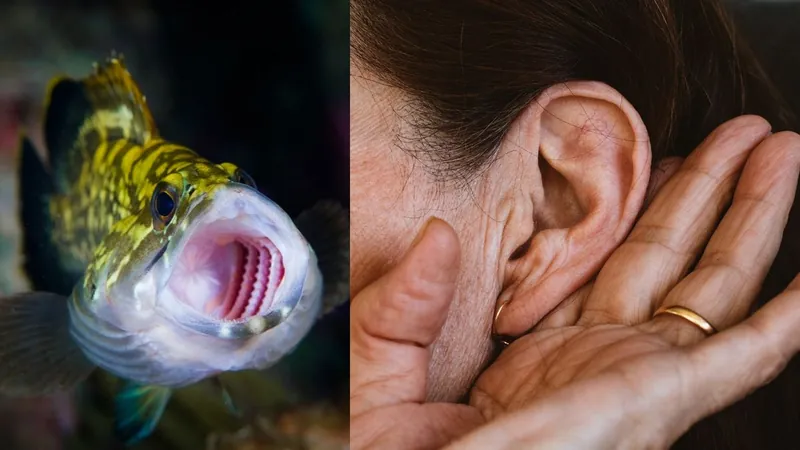
Shocking Revelation: Our Ears May Have Evolved from Fish Gills! Scientists Uncover Ancient Connection
2025-01-23
Author: Sarah
Study Reveals Link Between Human Ears and Fish Gills
In a groundbreaking study, researchers have revealed that the origins of human outer ears may trace back to the gills of prehistoric fish, suggesting an astonishing link between fish anatomy and mammalian evolution. This stunning discovery has opened new avenues in our understanding of how our unique anatomy has developed over millions of years.
Gene-Editing Experiments Reveal Evolutionary Pathways
Recent gene-editing experiments highlighted that the cartilage found in fish gills appears to have migrated into the ear canal long ago. Astonishingly, the study indicates that the evolutionary roots of our outer ears could even extend back to ancient marine invertebrates, such as horseshoe crabs, which are often referred to as 'living fossils' due to their remarkable resilience over the ages.
Insights from Gage Crump
'This project has radically shed light on the origins of outer ears, which were previously an enigma,' explained Gage Crump, a professor of stem cell biology and regenerative medicine at the University of Southern California, and co-author of the study. Researchers had already established that the middle ear structures in mammals evolved from the jawbones of ancient fish. This revelation prompted scientists to speculate whether the cartilage composition of the outer ear might originate from similar ancestral fish structures.
The Role of Elastic Cartilage
The outer ears of mammals, including humans, are primarily composed of elastic cartilage. This flexible type of cartilage is distinct from the hyaline cartilage found in the nose or the fibrocartilage present between our vertebrae. Crucially, the research revealed that elastic cartilage is also prevalent in fish gills, highlighting a potential shared evolutionary pathway.
Findings in Modern Fish
Using advanced protein staining techniques, the research team discovered the presence of elastic cartilage in the gills of modern bony fish species such as zebrafish and Atlantic salmon. These findings suggest that elastic cartilage is a common feature among contemporary fish, as detailed in the study published in the prestigious journal Nature.
Molecular Biology Insights
In a quest to further investigate the evolutionary relationship between the gills of fish and mammalian outer ears, the researchers turned to molecular biology. They focused on gene control elements known as 'enhancers,' which are crucial for regulating gene activity in specific tissues. By inserting human outer ear enhancers into zebrafish genomes, the team found evidence suggesting an ancestral relationship between the genes governing outer ear development and those in fish gills.
Experiment with Zebrafish and Mice
The research took an intriguing turn as scientists reversed the experiment, placing zebrafish gill enhancers into mouse genomes and detecting activity in the outer ears of the mice. The team also explored amphibians and reptiles, establishing that these creatures inherited their gill and ear structures from fish ancestors as well—a testament to the deep evolutionary history linking these diverse species.
Ancient Roots Revealed
Even more impressively, the researchers identified an enhancer in horseshoe crab cells that could activate genetic activity in zebrafish gills. This monumental finding indicates that the roots of our outer ears may stretch back even further—potentially over 400 million years into our evolutionary past.
Looking Ahead
While further research is essential to validate these findings, Gage Crump remarked, 'This study is just the beginning and adds a new chapter to the evolutionary saga of the mammalian ear.' As scientists continue to unravel the threads of evolution, who knows what other astonishing connections might be revealed? Stay tuned for more exciting revelations from the world of evolutionary biology!


 Brasil (PT)
Brasil (PT)
 Canada (EN)
Canada (EN)
 Chile (ES)
Chile (ES)
 Česko (CS)
Česko (CS)
 대한민국 (KO)
대한민국 (KO)
 España (ES)
España (ES)
 France (FR)
France (FR)
 Hong Kong (EN)
Hong Kong (EN)
 Italia (IT)
Italia (IT)
 日本 (JA)
日本 (JA)
 Magyarország (HU)
Magyarország (HU)
 Norge (NO)
Norge (NO)
 Polska (PL)
Polska (PL)
 Schweiz (DE)
Schweiz (DE)
 Singapore (EN)
Singapore (EN)
 Sverige (SV)
Sverige (SV)
 Suomi (FI)
Suomi (FI)
 Türkiye (TR)
Türkiye (TR)
 الإمارات العربية المتحدة (AR)
الإمارات العربية المتحدة (AR)